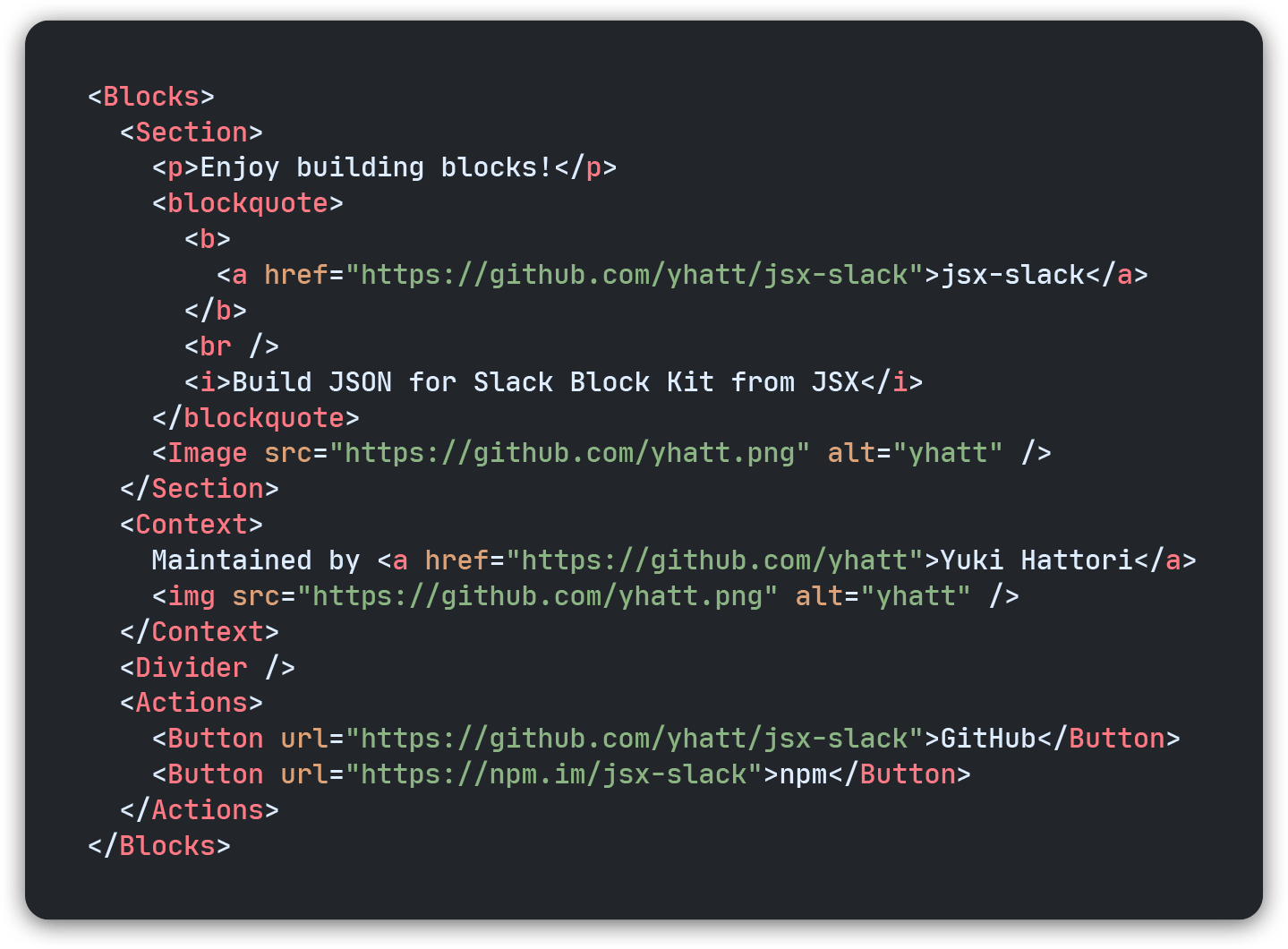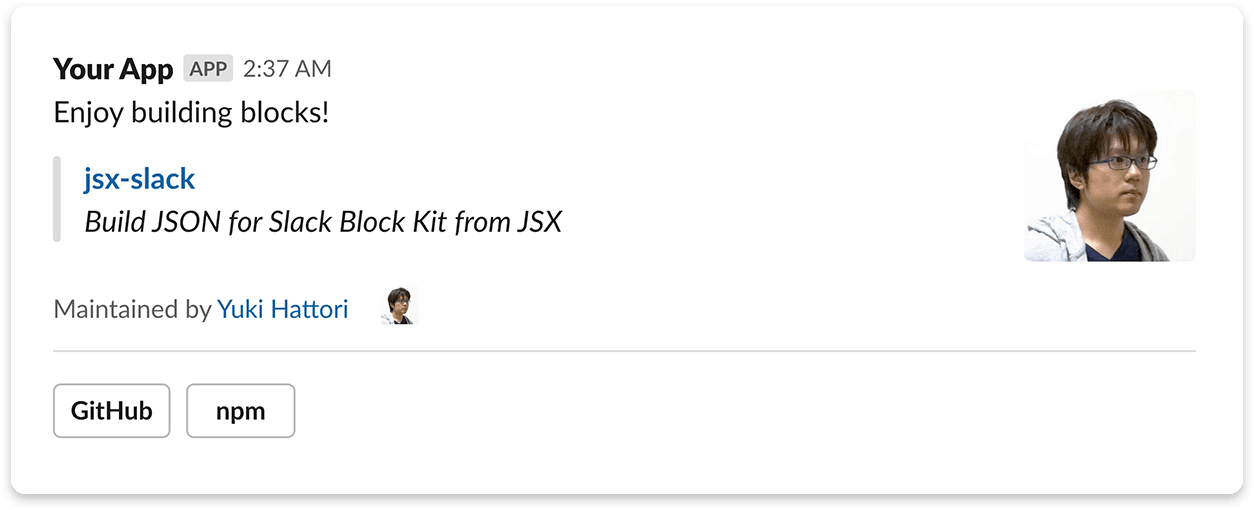Build JSON object for Slack Block Kit surfaces from readable JSX.
👉 Try our REPL demo in https://speee-jsx-slack.netlify.com/.
- Block Kit as components - Build contents for any surfaces by composing components for Block Kit with JSX.
- HTML-like formatting - Keep a readability by using well-known elements.
When developing Slack-integrated app, continuous maintenance of the rich contents is a difficult task. A team member must read and write JSON with deep knowledge about specifications of payload for Slack API.
Slack has shipped Block Kit and Block Kit Builder, and efforts to develop app easily. We believe JSX-based template would enhance a developer experience of Slack app to the next stage.
A project goal is creating an interface to compose maintainable contents for Slack with confidence via readable JSX.
jsx-slack would allow composing blocks with predictable HTML-like markup. It helps in understanding the structure of complex contents and interactions.
We require Node.js >= 8. If you are using TypeScript, we also require TS >= 3.0.
# npm
npm install --save @speee-js/jsx-slack# yarn
yarn add @speee-js/jsx-slackDo you hate troublesome setting up for JSX? All right. We provide jsxslack tagged template literal to build blocks right out of the box.
It allows the template syntax almost same as JSX, powered by HTM (Hyperscript Tagged Markup). Setting for transpiler and importing built-in components are not required.
This is a simple example of the template function just to say hello to someone.
import { jsxslack } from '@speee-js/jsx-slack'
export default function exampleBlock({ name }) {
return jsxslack`
<Blocks>
<Section>
Hello, <b>${name}</b>!
</Section>
</Blocks>
`
}When you want to use jsx-slack with JSX transpiler (Babel / TypeScript), you have to set up to use imported our parser JSXSlack.h. Typically, we recommend to use pragma comment /** @jsx JSXSlack.h */.
To create JSON from JSX, please wrap JSX by JSXSlack() function.
/** @jsx JSXSlack.h */
import JSXSlack, { Blocks, Section } from '@speee-js/jsx-slack'
export default function exampleBlock({ name }) {
return JSXSlack(
<Blocks>
<Section>
Hello, <b>{name}</b>!
</Section>
</Blocks>
)
}A prgama would work in Babel (@babel/plugin-transform-react-jsx) and TypeScript with --jsx react. You can use jsx-slack in either one.
After than, just use created template in Slack API. We are using the official Node SDK @slack/client in this example. See also Slack guide.
import { WebClient } from '@slack/client'
import exampleBlock from './example'
const web = new WebClient(process.env.SLACK_TOKEN)
web.chat
.postMessage({
channel: 'C1232456',
blocks: exampleBlock({ name: 'Yuki Hattori' }),
})
.then(res => console.log('Message sent: ', res.ts))
.catch(console.error)It would post a simple Slack message like this:
Slack has recommended to use Block Kit for building tempting messages and modals.
By using jsx-slack, you can build a template with piling up Block Kit blocks by JSX. It is feeling like using components in React or Vue.
<Blocks>
<Section>
<p>Enjoy building blocks!</p>
<blockquote>
<b>
<a href="https://github.com/speee/jsx-slack">@speee-js/jsx-slack</a>
</b>
<br />
<i>Build JSON for Slack Block Kit from JSX</i>
</blockquote>
<Image src="https://github.com/speee.png" alt="Speee, Inc." />
</Section>
<Context>
Maintained by <a href="https://github.com/yhatt">Yuki Hattori</a>
<img src="https://github.com/yhatt.png" alt="yhatt" />
</Context>
<Divider />
<Actions>
<Button url="https://github.com/speee/jsx-slack">GitHub</Button>
<Button url="https://www.npmjs.com/package/@speee-js/jsx-slack">npm</Button>
</Actions>
</Blocks><Modal title="My first modal" close="Cancel">
<Section>
<p>
<strong>It's my first modal!</strong> :sunglasses:
</p>
<p>jsx-slack also has supported Slack Modals.</p>
</Section>
<Divider />
<Input type="text" name="subject" label="Subject" required />
<Textarea name="message" label="Message" maxLength={500} />
<ConversationsSelect name="shareWith" label="Share with..." required />
<Input type="hidden" name="postId" value="xxxx" />
<Input type="submit" value="Send" />
</Modal>For home tab (experimental)
<Home>
<Image src="https://source.unsplash.com/random/960x240?home" alt="home" />
<Section>
<b>Welcome back to my home!</b> :house_with_garden:
</Section>
<Divider />
<Section>What's next?</Section>
<Actions>
<RadioButtonGroup value="tickets">
<RadioButton value="tickets">See assigned tickets :ticket:</RadioButton>
<RadioButton value="reminder">Remind a task later :memo:</RadioButton>
<RadioButton value="pomodoro">Start pomodoro timer :tomato:</RadioButton>
</RadioButtonGroup>
<Button actionId="start" style="primary">
Start working
</Button>
</Actions>
</Home>
⚠️ Dialog components provided by@speee-js/jsx-slack/dialogare now deprecated in favor of Modals whose supported Block Kit. You can still use that entry point for the outdated dialog of Slack, but you should migrate into Modals because we would be removed@speee-js/jsx-slack/dialogin v1.
Show deprecated details...
We also provide @speee-js/jsx-slack/dialog to allow building Dialog JSON with same feeling. You can create Dialog JSON for dialog argument in dialog.open Slack API, with familiar HTML form style.
/** @jsx JSXSlack.h */
import JSXSlack from '@speee-js/jsx-slack'
import { Dialog, Input, Textarea } from '@speee-js/jsx-slack/dialog'
export default function exampleDialog(data) {
return JSXSlack(
<Dialog callbackId="create" title="Create">
<Input name="name" label="Name" value={data.name} required />
<Textarea name="desc" label="Description" value={data.desc} />
<Input type="hidden" name="userId" value={data.userId} />
<Input type="submit" value="Create" />
</Dialog>
)
}As like as React, jsx-slack provides <Fragment> (<JSXSlack.Fragment>) component for higher-order component (HOC) consited of multiple blocks or elements.
For example, you can define the custom block by grouping some blocks with <Fragment> if you were using JSX transpiler.
Let's say defines <Header> custom block that is consisted by <Section> and <Divider>.
/** @jsx JSXSlack.h */
import JSXSlack, { Fragment } from '@speee-js/jsx-slack'
const Header = ({ children }) => (
<Fragment>
<Section>
<b>{children}</b>
</Section>
<Divider />
</Fragment>
)Now the defined block can use in <Blocks> as like as the other blocks:
<Blocks>
<Header>
<i>jsx-slack custom block</i> :sunglasses:
</Header>
<Section>Let's build your block.</Section>
</Blocks>If you want to use the short syntax <></> for fragments in Babel transpiler, we recommend to set an extra pragma command /** @jsxFrag JSXSlack.Fragment */.
/** @jsx JSXSlack.h */
/** @jsxFrag JSXSlack.Fragment */
import JSXSlack from '@speee-js/jsx-slack'
const Header = ({ children }) => (
<>
<Section>
<b>{children}</b>
</Section>
<Divider />
</>
)
⚠️ TypeScript cannot customize the factory method for fragment syntax. (Microsoft/TypeScript#20469) Please use<Fragment>component as usual.
You should use jsxslack.fragment template literal tag instead of jsxslack when you want to create HOC or custom block with prefering template literal to JSX transpiler.
// Header.js
import { jsxslack } from '@speee-js/jsx-slack'
const Header = ({ children }) => jsxslack.fragment`
<Section>
<b>${children}</b>
</Section>
<Divider />
`
export default Header<Fragment> built-in component does not have to use because the parser allows multiple elements on the root.
A defined component may use in jsxslack tag as below:
import { jsxslack } from '@speee-js/jsx-slack'
import Header from './Header'
console.log(jsxslack`
<Blocks>
<${Header}>
<i>jsx-slack custom block</i> :sunglasses:
<//>
<Section>Let's build your block.</Section>
</Blocks>
`)Please notice to a usage of component that has a bit different syntax from JSX.
In case using deprecated dialog components on the out of
<Dialog>within template literal, you have to useDialog.prefix such as<Dialog.Select>.
- slack-jsx - Compose Slack messages from JSX Components instead of writing JSON.
- react-chat-renderer - React renderer implementation for building rich Slack messages using JSX.
Managed by ![]() Speee, Inc. (@speee)
Speee, Inc. (@speee)
 Yuki Hattori (@yhatt) - Maintainer
Yuki Hattori (@yhatt) - Maintainer







